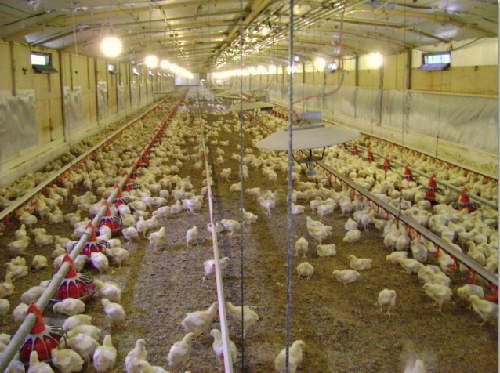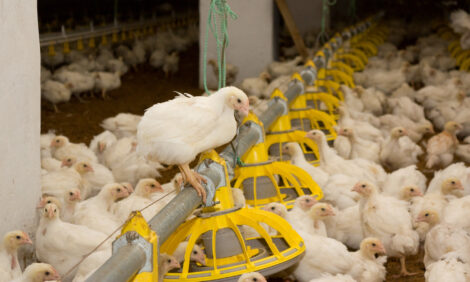



Air Velocity Management for Optimum Broiler Performance
Michael Longley, Global Technical Transfer Manager with Aviagen, Inc., highlights the importance of providing the correct air speed within the broiler house, and suggests some practical ideas for creating and maintaining optimum air flow at bird level.
Introduction
Ventilation is one of the most important, but often mismanaged, aspects of broiler production. Sub-optimal ventilation at any point during the broiler grow-out can negatively affect the flock and the production managers results at the time of processing.
The main purpose of ventilation is to keep the birds within a flock comfortable, or within their 'thermo-neutral zone', while maintaining optimum air quality and removing excess heat, harmful gases, moisture and dust from the house environment. In simple terms, a 'thermo-neutral zone' is a uniform, balanced environment where the birds feel most comfortable and exhibit maximum energy (feed) intake for minimum energy expenditure. Energy will be converted as bodyweight gain rather than expended to produce heat, if it is too cold or lost through increased respiration if it is too hot.
Air velocity, or the speed at which air enters the broiler house, is just one aspect of ventilation that must be managed correctly to ensure that the population grows in a balanced environment. Incorrect air velocity has a direct impact on bird comfort, and if mismanaged, will create uneven growing conditions.
Bird behaviour should always be monitored closely during any stage of the broiler grow-out and air speeds adjusted until birds are seen to be comfortable once more.
This article will highlight the importance of providing the correct air speed within the broiler house, and suggests some practical ideas for creating and maintaining optimum air flow at bird level.
*
"A uniform, balanced environment is essential to maintain birds within their comfort zone to achieve optimum performance levels."
Air Velocity and Environmental Balance
Air that is travelling too fast increases wind chill to the birds, reducing the effective temperature (the temperature the birds feel). In this instance, birds tend to huddle or group together and litter quality may be affected, especially in colder conditions (Figure 1).
Air that is travelling too slowly will cause a build-up of heat, moisture, and potentially harmful gases such as ammonia and carbon dioxide within the house. This will directly impact litter quality during colder times of the year and have a dramatic impact on livability, particularly during the hotter months of the year. In both cases, performance will be affected, as the birds are being pushed outside of their comfort zone.

Negative Pressure
The speed at which air enters a broiler house through the side wall inlets is dictated by how low the negative pressure within the house is. In an environmentally controlled house, the fans pull the air within the house out, creating a negative pressure situation inside the house. This negative pressure will then pull air from the outside, which is at a higher pressure, into the broiler house through the side wall inlets. This will replace the air that was removed by the fans. The lower the house negative pressure, the higher the speed of the air entering the house.
In a naturally ventilated house, negative pressure is created by air movement (wind) over the roof, from one side of the house to the other. As the air moves over roof, it pulls the air within the house with it, and thus reduces the pressure. This reduction in pressure forces the air into the house from the opposite side to replace the air that was removed. Without the wind speed across the house, it is very difficult to ventilate an open sided or naturally ventilated house effectively, and without negative pressure being present within the broiler house, very little air will actually enter.


In environmentally controlled houses, house tightness is an essential consideration for achieving a good, reliable negative pressure. This means that all cracks, holes and any poorly fitting panels and doors should be sealed, to ensure that air only enters where it is meant to, such as through house side wall or ceiling inlets.
To check house tightness:
- Close all doors, inlets and fans.
- Enter the house and turn off any lights that are on.
- Wait until your eyes acclimatize to the dark and look around the house.
- Any unwanted cracks and holes can easily be seen, as light will 'leak' in through them.
*
"A negative pressure must be present in a house to control and maintain air velocity."
The easiest and least expensive way to seal these areas is with an expandable foam product. To test the effectiveness of the sealing procedure, it is a good idea to use a pressure meter (anemometer) to test house pressure, both before and after sealing. To do this:
- Set up the pressure meter following the usage instructions provided with the equipment, and ensure that the outside pressure pipe is correctly situated.
- Close all doors and inlets.
- Switch on one 122-cm (48-inch) / 127-cm (50-inch) fan or two 91-m (36-inch) fans.
- Record the pressure reading.
- Repeat this process when all sealing has been completed and compare the two readings.
- House pressure should reach a minimum of 0.15 inches of water column or 37.5Pa after sealing.
Air Speed, Direction and House Pressure
The direction at which air enters a house is extremely influential on bird performance and is linked with house pressure (how fast air enters the house), house design, inlet design and opening size.
Figure 4 shows an example of how different house pressures affect the direction that air enters into a 12-metre (39-foot) house.

Table 1 indicates the minimum pressure required for houses of different widths to achieve the correct air speed and direction for minimum ventilation.
| Table 1. House width and related house pressure required for correct air direction and speed |
|||
| House width | Suggested house pressure to achieve correct air direction and speed | ||
|---|---|---|---|
| (metres) | (feet) | (Pa) | (Inches of H2O) |
| 10 | 33 | -10.0 | 0.04 |
| 12 | 39 | -12.5 | 0.05 |
| 14 | 46 | -15.0 | 0.06 |
| 15 | 49 | -17.5 | 0.07 |
| 18 | 59 | -20.0 | 0.08 |
The direction that air enters the broiler house is highly dependent on inlet opening space and design. An inlet that is fully open may cause air to drop directly on top of the birds, pushing them outside their thermo-neutral zone. However, inlets that are not open enough will increase the house pressure and air speed, bringing air into the house too quickly, and not allowing it to mix effectively, particularly during minimum ventilation. Opened vents should be spaced equally down the length of the house. For older birds, and as ventilation rates increase (more fans turned on), inlets must be opened wider, however adequate negative pressure must be maintained.
As a basic rule of thumb, an inlet opening of about 5cm (2.0 inches) should be adequate to provide enough air for minimum ventilation.
A good visual measure for monitoring air speed and direction during minimum ventilation can be obtained by using 15-cm (6-inch) lengths of cassette tape hung from the ceiling every 1.0-1.5 metres (3-5 feet), positioned in front of an air inlet and up to the apex of the ceiling. When the fans are on, every strip of tape should move, including the one closest to the roof apex. The tape closest to the inlet should move significantly up against the ceiling of the house. Tape movement should reduce the closer to the ceiling apex, where the apex tape should only move slightly. This shows that the incoming air is just about to reach the middle of the house, has stopped and is starting to move downward.
For both minimum ventilation and tunnel ventilation, smoke testing may also be a good diagnostic tool. Smoke gives us another visual indicator of how air is entering the house, and at what speed and direction. For example, if an air speed meter is not available during tunnel ventilation, recording the length of time it takes a plume of smoke to travel from the inlet end of the house to the fan end, allows calculation of house average air speed. However, it is important to note that this only gives average air speed and does not identify any areas where air speed reduces down the length of the house, or whether there are any so called “dead spots” or disruptions within the house.
To perform smoke testing within a broiler house:
- Start the tunnel fans and open the tunnel inlet vents, corresponding to the number of fans running.
- Start smoke emitter or smoke bomb at the inlet end of the house at the same time as starting a timer.
- When the smoke reaches the fan end of the house, stop the timer and record the time.
- To calculate air speed:
- In metres per second - Divide the length of the house in metres by the time recorded or
- In feet per minute - Divide the length of house in feet by the time recorded and multiply by 60.
Summary
The purpose of good ventilation management is to keep birds within their thermo-neutral zone. Incorrect ventilation techniques push the flock outside this zone and cause losses in FCR and bodyweight gain, potentially decreasing livability levels both during the summer, from high humidity and temperature, and during the winter from excesses of harmful gases and moisture.
If poultry houses are sealed properly and negative pressures are correct, incoming air speed will also be correct.
Inlet openings must be managed correctly with uniform distribution down the length of the house, and an increasing inlet size according to the age of the flock and their increasing ventilation needs.
Using cassette tape and smoke testing regularly allows us to measure and monitor correct air flow and speeds for both minimum and tunnel ventilation.
All ventilation problems are detectable and quantifiable and should be managed effectively to reduce any economic losses to the grower and company.
August 2014










